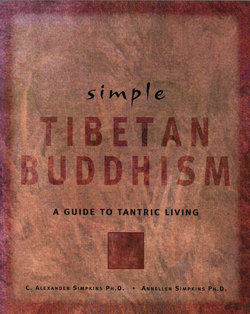Читать книгу Simple Tibetan Buddhism - Annellen Simpkins M. - Страница 7
На сайте Литреса книга снята с продажи.
ОглавлениеINTRODUCTION
The Dalai Lama has been very much in the public eye in recent years, both as the winner of a Nobel Peace Prize and as a spokesman for freedom and compassion. Still, many people do not know about the long and colorful tradition he leads, Tibetan Buddhism.
Tibetan Buddhism is a form of Buddhism that, through a method of inner transformation, offers an active way of enhancing life. It is transformation that is accomplished through various methods and techniques that engage the mind, the senses, and one’s behavior. With these practices, a person learns to experience a vibrant life filled with color and beauty.
Modern culture has pushed to secularize life, to separate the spiritual from the material. But Tibetan Buddhism believes there is nothing that can’t be sanctified, nothing that can’t be a symbol of the spiritual,—that can’t awaken in us our deeper, spiritual natures. Everything we do, even the simplest daily routines, can be meaningful. And then, when life is over, we can learn how to face death with a clear, calm mind, even look upon death as an opportunity to transform consciousness.
Virtue, Tibetans believe, can be taught, and they have devised a carefully worked out system that trains the mind to become enlightened. It takes time and effort, but it can be done. And anyone can do it. Virtue is altruism: love, kindness, compassion, and tolerance. Tibetan Buddhism teaches people how to free themselves from those things that interfere with expressing their own best qualities. The ultimate goal in Tibetan Buddhism is to become a compassionate, caring human being who can live fully and happily, whatever the circumstance, enriched by everyday life as an expression of nirvana—enlightenment.
ABOUT THIS BOOK
Simple Tibetan Buddhism is written to introduce you to this form of Buddhism and to show you how you can adapt it to enhance your life. Part I traces the background and development of Tibetan Buddhism to the present day, highlighting pivotal people who helped to make it what it is. Part II explains important themes and methods. Tibetan Buddhists are very pragmatic in that the techniques they have developed are intended to help people travel to enlightenment more quickly and fully. Part III introduces practical exercises so you can try aspects of Tibetan Buddhism for yourself. You can experiment with meditations and learn how to apply them in your own life. Ultimately, you can discover your deeper self and live in accord with it.
HOW TO USE THIS BOOK
Meditate! The meditations in this book can be learned by anyone, but they do take practice. Do not be discouraged if some exercises are difficult. If you have trouble with one method, try another. The book offers a variety of techniques to speak to all sorts of people.
Be honest with yourself! If you sincerely and patiently try to correct yourself as you go along, you will progress. For those who would like to pursue this path more comprehensively, there are numerous Tibetan Buddhist organizations that will welcome and teach you further.
Even though enlightenment is the goal, keep in mind that it is not something beyond you or outside of what and who you are. The Path is one of self-discovery, of bringing out the innate potential that is already present. May you enjoy the journey.
